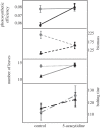Evidence for an epigenetic role in inbreeding depression
- PMID: 22791708
- PMCID: PMC3441007
- DOI: 10.1098/rsbl.2012.0494
Evidence for an epigenetic role in inbreeding depression
Abstract
Inbreeding depression (i.e. negative fitness effects of inbreeding) is central in evolutionary biology, affecting numerous aspects of population dynamics and demography, such as the evolution of mating systems, dispersal behaviour and the genetics of quantitative traits. Inbreeding depression is commonly observed in animals and plants. Here, we demonstrate that, in addition to genetic processes, epigenetic processes may play an important role in causing inbreeding effects. We compared epigenetic markers of outbred and inbred offspring of the perennial plant Scabiosa columbaria and found that inbreeding increases DNA methylation. Moreover, we found that inbreeding depression disappears when epigenetic variation is modified by treatment with a demethylation agent, linking inbreeding depression firmly to epigenetic variation. Our results suggest an as yet unknown mechanism for inbreeding effects and demonstrate the importance of evaluating the role of epigenetic processes in inbreeding depression.
Figures


Comment in
-
Epigenetics as a new avenue for the role of inbreeding depression in evolutionary ecology.Heredity (Edinb). 2013 Mar;110(3):205-6. doi: 10.1038/hdy.2012.66. Epub 2012 Oct 10. Heredity (Edinb). 2013. PMID: 23047201 Free PMC article. No abstract available.
Similar articles
-
European Society for Evolutionary Biology meeting. Epigenetics linked to inbreeding depression.Science. 2011 Sep 16;333(6049):1563. doi: 10.1126/science.333.6049.1563. Science. 2011. PMID: 21921171 No abstract available.
-
Evaluation of the extent of among-family variation in inbreeding depression in the perennial herb Scabiosa columbaria (Dipsacaceae).Am J Bot. 2004 Aug;91(8):1183-9. doi: 10.3732/ajb.91.8.1183. Am J Bot. 2004. PMID: 21653474
-
Epigenetics as a new avenue for the role of inbreeding depression in evolutionary ecology.Heredity (Edinb). 2013 Mar;110(3):205-6. doi: 10.1038/hdy.2012.66. Epub 2012 Oct 10. Heredity (Edinb). 2013. PMID: 23047201 Free PMC article. No abstract available.
-
The evolutionary ecology of inbreeding depression in wild plant populations and its impact on plant mating systems.Front Plant Sci. 2024 Sep 9;15:1359037. doi: 10.3389/fpls.2024.1359037. eCollection 2024. Front Plant Sci. 2024. PMID: 39315378 Free PMC article. Review.
-
Epigenetic Changes Occurring in Plant Inbreeding.Int J Mol Sci. 2023 Mar 12;24(6):5407. doi: 10.3390/ijms24065407. Int J Mol Sci. 2023. PMID: 36982483 Free PMC article. Review.
Cited by
-
No evidence for local adaptation and an epigenetic underpinning in native and non-native ruderal plant species in Germany.Ecol Evol. 2019 Aug 6;9(17):9412-9426. doi: 10.1002/ece3.5325. eCollection 2019 Sep. Ecol Evol. 2019. PMID: 31534665 Free PMC article.
-
epiGBS: reference-free reduced representation bisulfite sequencing.Nat Methods. 2016 Apr;13(4):322-4. doi: 10.1038/nmeth.3763. Epub 2016 Feb 8. Nat Methods. 2016. PMID: 26855363
-
Rearing environment affects the genetic architecture and plasticity of DNA methylation in Chinook salmon.Heredity (Edinb). 2021 Jan;126(1):38-49. doi: 10.1038/s41437-020-0346-4. Epub 2020 Jul 22. Heredity (Edinb). 2021. PMID: 32699390 Free PMC article.
-
Epigenetic regulation of sex ratios may explain natural variation in self-fertilization rates.Proc Biol Sci. 2015 Nov 22;282(1819):20151900. doi: 10.1098/rspb.2015.1900. Proc Biol Sci. 2015. PMID: 26559950 Free PMC article.
-
The DNA methylation level against the background of the genome size and t-heterochromatin content in some species of the genus Secale L.PeerJ. 2017 Jan 24;5:e2889. doi: 10.7717/peerj.2889. eCollection 2017. PeerJ. 2017. PMID: 28149679 Free PMC article.
References
-
- Charlesworth B., Charlesworth D. 1999. The genetic basis of inbreeding depression. Genet. Res. 74, 329–34010.1017/s0016672399004152 (doi:10.1017/s0016672399004152) - DOI - DOI - PubMed
-
- Carr D. E., Dudash M. R. 2003. Recent approaches into the genetic basis of inbreeding depression in plants. Phil. Trans. R. Soc. Lond. B 358, 1071–108410.1098/rstb.2003.1295 (doi:10.1098/rstb.2003.1295) - DOI - DOI - PMC - PubMed
-
- Pray L. A., Goodnight C. J. 1995. Genetic variation in inbreeding depression in the red flour beetle Tribolium castaneum. Evolution 49, 176–18810.2307/2410303 (doi:10.2307/2410303) - DOI - DOI - PubMed
-
- Kristensen T. N., Pedersen K. S., Vermeulen C. J., Loeschcke V. 2010. Research on inbreeding in the ‘omic’ era. Trends Ecol. Evol. 25, 44–5210.1016/j.tree.2009.06.014 (doi:10.1016/j.tree.2009.06.014) - DOI - DOI - PubMed
-
- Armbruster P., Reed D. H. 2005. Inbreeding depression in benign and stressful environments. Heredity 95, 235–24210.1038/sj.hdy.6800721 (doi:10.1038/sj.hdy.6800721) - DOI - DOI - PubMed
Publication types
MeSH terms
Substances
LinkOut - more resources
Full Text Sources
Other Literature Sources

